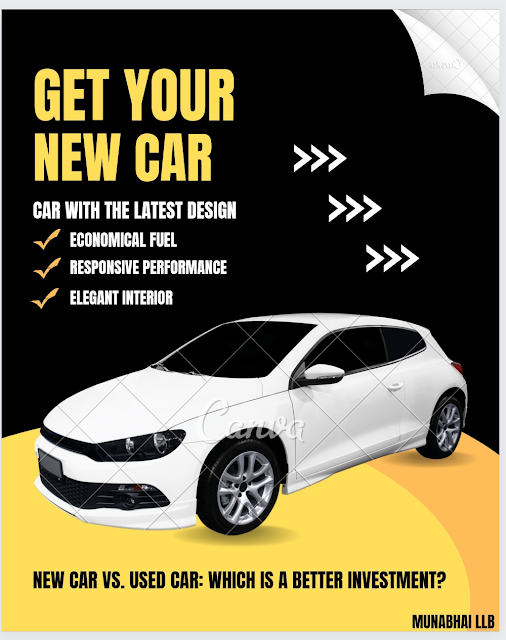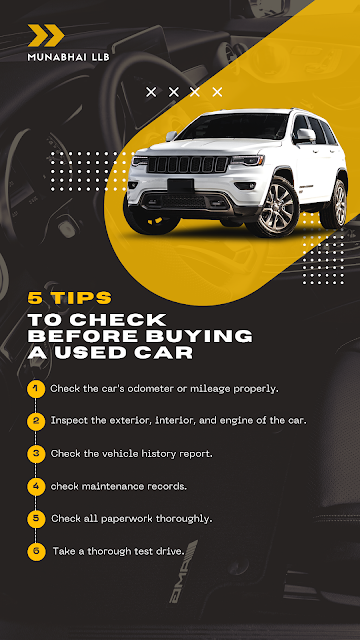New car vs. Used Car: Which Is a Better Investment?
New car vs. Used Car: Which Is a Better Investment?
Introduction :-
Making the choice between a new and used car can be difficult. Finding the ideal balance between affordability, dependability, and depreciation can have a big impact on your long-term investment because both solutions have their own set of benefits and drawbacks. To assist you in making an informed choice, we will examine the most frequently asked questions concerning new and used cars in this extensive blog post. Let's start now!
1. Q :- What are the primary advantages of purchasing a new car?
A: Buying a new automobile has a number of benefits, such as access to cutting-edge technology, enhanced safety features, a guarantee for peace of mind, and the excitement of being the first owner. The majority of new automobiles are more fuel-efficient, and you may customize them to your tastes.
With a new car, you don’t have to worry about:
• Previous mechanical issues
• Leftover smells
• Existing dings or dents
• Miles on the odometer
• Former accidents
Also Read :- Is it Safe to Buy Mobile Phones Online? A Comprehensive Guide
Also Read :- Mobile Data Recovery: A Comprehensive Guide to Retrieving Lost Data
2. Q :-How does depreciation impact the value of a new car?
A: The first few years of owning a new car result in significant depreciation. A new car can typically lose up to 20 to 30 percent of its value in the first year and about 50 percent in the first three. When evaluating the new car as an investment over the long run, this depreciation may be a significant consideration.
Age of Car Rate of Depreciation
0-6 months 5%
6 months – 1 year 15%
1 year – 2 years 20%
2 years – 3 years 30%
3 years – 4 years 40%
4 years – 5 years 50%
Above 5 years (for obsolete models) Mutually decided between the insurer and vehicle owner
3. Q :- Is there a benefit to purchasing a used car?
A: Buying a secondhand car has its own unique set of advantages. The cost savings over purchasing new is the most important benefit. Since used cars have already experienced the greatest depreciation, you can purchase a dependable vehicle for less money. Moreover, used cars typically have lower insurance and registration expenses.
Consumers complain about how quickly a new car depreciates—as soon as they drive it off the lot. The value of a new vehicle can drop 11% on the drive home meaning your $20,000 vehicle is worth only $17,800 once it leaves the lot. The vehicle continues depreciation as weeks, months, and years pass. With used vehicles, the bulk of the depreciation has already occurred. Some used vehicles may even gain value! Edmunds has provided a handy “True Cost to Own” tool that provides how much a vehicle will really cost and how quickly the vehicle will lose value.
4. Q:-How can I make sure a used car is reliable?
A: Thorough investigation and inspection are necessary to determine a secondhand car's dependability. Think about purchasing from trustworthy dealers or certified pre-owned programs with guarantees. To check for previous collisions or significant repairs, obtain a car history record. Additionally, having a reliable mechanic examine the vehicle prior to buying might offer important information about its condition.
• A test drive should be long enough to tell you about the working condition of a vehicle, insist on driving for at least 5 kms through various types of roads to understand the car and your comfort.
• The car should start instantly and there shouldn’t be any strange noises apart from the hum of the engine.
• Gears should shift smoothly and upon releasing the clutch the vehicle should move forward without jerks.
• The steering should not vibrate. If it does then there is a major problem.
• The brakes should also slow down proportionally to the force applied to them and this should happen in a straight line, the car shouldn’t move sideways. If it does then the car has a major braking issue.
• Lastly, check for oil leaks from the engine and the gearbox. Park the vehicle on clean ground and check if anything has leaked or not. If it has then there are issues that need to be looked into.
5. Q. Do pre-owned vehicles have warranties?
A: Warranties on used automobiles are possible, but the extent of the protection may differ depending on the age, mileage, and dealer- or manufacturer-specific restrictions. Extended warranties are frequently included with certified pre-owned (CPO) vehicles, adding to the peace of mind. A certified pre-owned car, or CPO for short, is a 1- to 5-year-old vehicle that has been lightly used, thoroughly inspected and covered by a manufacturer-backed extended warranty. The CPO warranty often kicks in once the new-car warranty has expired and typically adds one to two years of coverage. Certified pre-owned programs also offer additional benefits, which may include roadside assistance, free maintenance, satellite radio subscription and trip interruption coverage. Finally, some CPO vehicles might even have low finance rates, offered as promotions that are lower than a traditional used-car deal. Those benefits come at a cost, however, as certified pre-owned vehicles are typically more expensive than equivalent non-CPO vehicles.
6. Q. How do a car's mileage and age affect its performance?
A: Older vehicles with higher mileage are typically more prone to mechanical problems. As cars get older, parts deteriorate and repairs might need to be made more frequently. However, a used automobile with good maintenance and low miles can still deliver dependable performance for many years.
Calculating the average mileage of a car is tricky. According to government statistics, the average number of miles driven by cars in England each year was 7,400 miles in 2019 (the latest figures are for 2020, but they’re skewed downwards due to pandemic lockdowns so we’ve based the average on 2019 figures as it was a more normal year).
So, if you know how old a car is, then you can multiply the number of years by that average. For example, a five-year-old car could be expected to have 37,000 miles on the clock (5 X 7,400 = 37,000).
However, this number isn’t the be-all and end-all – where and how it’s been driven are also big factors.
7. Q. How do the insurance rates for secondhand cars compare?
A: Due to their higher replacement value, new cars often have higher insurance costs. On the other side, used cars typically have lower insurance premiums because they are less expensive to replace. However, other elements including the car's make, model, age, and driving history also affect insurance costs.
New Car Insurance :-
•New cars have a higher Insured Declared Value (IDV). Hence, the premium portion corresponding to the IDV is higher in comparison to used cars.
•The new cars will have the latest safety equipment. Hence, these vehicles pose less risk with respect to theft. Corresponding to this factor, the component of the insurance premium will be lower.
• New vehicles cost more to repair. Hence, the insurance charges may be slightly higher.
•New cars are not prone to breakdowns and other such unforeseen events, which result in huge expenditure. This contributes to lower insurance premiums.
Used Car Insurance :-
• Used cars are often targeted by thieves as these vehicles do not have strong security systems.
•It is cheaper to get old cars repaired.
•Older cars are more prone to break down and total damage. This means that the premium may be higher.
•Since the IDV of used cars is lower, the premium corresponding to this component is lower.
8. Q. New or old cars—which is better for the environment?
A: Generally speaking, buying a secondhand automobile is preferable in terms of the environment. More energy and resources are used in the production of new cars, increasing their carbon footprint. You are effectively recycling resources by buying a secondhand car, which lowers the demand for new car production.
9. Q. How can I increase a new or used car's resale value?
A: You may increase your car's resale value by performing routine maintenance, keeping thorough service logs, and taking care of its looks. Consider models with high resale value when buying a new automobile, and prefer well-liked, dependable models over those with severe wear and tear when buying a used car.
10. Q . Are there any benefits to purchasing a secondhand vehicle?
A :- Yes, buying a used car has a number of benefits. The biggest benefit is the price difference between used and new cars, which can save you thousands of dollars. Used cars will also hold their worth better over time due to their more steady depreciation rate. Additionally, before making a purchase, you can look into the car's history and reviews to judge its dependability.
- Depreciates at a Slower Rate.
- Lower Insurance Costs.
- Assured Reliability.
- Certified Cars, Backed by Technology and Team.
- Offers Good Variety Within Your Budget.
- Saves Money.
- Financing is Easy and Rates Are Favorable.
- Lower registration fees.
11.Q . Which alternative, new or used cars, offers better financing options?
A :-The financing choices for new and used cars can differ. Financing options for new cars could be more alluring, with things like longer loan periods or cheaper interest rates. However, because they are seen as carrying a larger risk, used cars typically have higher interest rates. In some circumstances, a new car's superior finance terms may make up for the initial greater cost, making it longer term more reasonable.
Conclusion:
In conclusion, your money, priorities, and tastes will ultimately determine whether you purchase a new or used car. Although they come with the newest technology and peace of mind, new cars depreciate more quickly. On the other side, secondhand cars are less expensive but need more in-depth investigation and examination to guarantee reliability. Make a decision based on your needs, the benefits and disadvantages, and your financial objectives and lifestyle. In the long run, a well-maintained car, whether it is new or secondhand, can be a worthwhile investment.
Also Read :- Is it Safe to Buy Mobile Phones Online? A Comprehensive Guide
Also Read :- Mobile Data Recovery: A Comprehensive Guide to Retrieving Lost Data
Hindi translation :-
हिन्दी मे अनुवाद :-
नई कार बनाम प्रयुक्त कार: कौन सा बेहतर निवेश है?
परिचय:-
नई या पुरानी कार खरीदने के बीच निर्णय करना एक कठिन काम हो सकता है। दोनों विकल्प अपने-अपने फायदे और नुकसान के साथ आते हैं, और सामर्थ्य, विश्वसनीयता और मूल्यह्रास के बीच सही संतुलन ढूंढना आपके दीर्घकालिक निवेश पर महत्वपूर्ण प्रभाव डाल सकता है। इस व्यापक ब्लॉग पोस्ट में, हम विस्तृत उत्तरों के साथ नई और प्रयुक्त कारों के बारे में अक्सर पूछे जाने वाले प्रश्नों का पता लगाएंगे, ताकि आपको एक सूचित निर्णय लेने में मदद मिल सके। आइए गोता लगाएँ!
अक्सर पूछे जाने वाले प्रश्न:
1. प्रश्न: नई कार खरीदने के मुख्य लाभ क्या हैं?
उत्तर: नई कार खरीदने पर कई फायदे मिलते हैं, जिनमें नवीनतम तकनीक, बेहतर सुरक्षा सुविधाएँ, मानसिक शांति के लिए वारंटी और पहला मालिक होने की खुशी शामिल है। नई कारें आम तौर पर अधिक ईंधन-कुशल होती हैं, और आप उन्हें अपनी प्राथमिकताओं के अनुरूप अनुकूलित कर सकते हैं।
नई कार के साथ, आपको निम्नलिखित के बारे में चिंता करने की ज़रूरत नहीं है:
• पिछले यांत्रिक मुद्दे
• बची हुई गंध
• मौजूदा डेंट या डेंट
•ओडोमीटर पर मील
•पूर्व दुर्घटनाएँ
2. प्रश्न: मूल्यह्रास नई कार के मूल्य को कैसे प्रभावित करता है?
उत्तर: स्वामित्व के पहले कुछ वर्षों के दौरान नई कारों में महत्वपूर्ण मूल्यह्रास का अनुभव होता है। औसतन, एक नई कार पहले वर्ष के भीतर अपने मूल्य का 20-30% तक और पहले तीन वर्षों के भीतर लगभग 50% तक खो सकती है। किसी नई कार के दीर्घकालिक निवेश मूल्य पर विचार करते समय यह मूल्यह्रास एक प्रमुख कारक हो सकता है।
कार की आयु मूल्यह्रास की दर
0-6 महीने 5%
6 महीने - 1 वर्ष 15%
1 वर्ष - 2 वर्ष 20%
2 वर्ष - 3 वर्ष 30%
3 वर्ष - 4 वर्ष 40%
4 वर्ष - 5 वर्ष 50%
5 वर्ष से अधिक (अप्रचलित मॉडलों के लिए) बीमाकर्ता और वाहन मालिक के बीच पारस्परिक रूप से निर्णय लिया जाता है
3. प्रश्न: क्या पुरानी कार खरीदने के कोई फायदे हैं?
उत्तर: हां, पुरानी कार खरीदने के अपने फायदे होते हैं। सबसे महत्वपूर्ण लाभ नया खरीदने की तुलना में कम लागत है। प्रयुक्त कारों में पहले से ही सबसे अधिक मूल्यह्रास हो चुका है, जिससे आप कम कीमत पर एक विश्वसनीय वाहन प्राप्त कर सकते हैं। इसके अलावा, प्रयुक्त कारों के लिए बीमा और पंजीकरण लागत कम होती है।उपभोक्ता इस बात की शिकायत करते हैं कि एक नई कार का मूल्य कितनी जल्दी कम हो जाता है - जैसे ही वे उसे गाड़ी से बाहर निकालते हैं। एक नए वाहन का मूल्य घर तक ड्राइव करने पर 11% कम हो सकता है, जिसका अर्थ है कि आपका $20,000 का वाहन घर छोड़ने के बाद केवल $17,800 का होगा। सप्ताह, महीने और वर्ष बीतने के साथ वाहन का मूल्यह्रास जारी रहता है। प्रयुक्त वाहनों के मामले में, मूल्यह्रास का बड़ा हिस्सा पहले ही आ चुका है। कुछ प्रयुक्त वाहनों का मूल्य भी बढ़ सकता है! एडमंड्स ने एक आसान "ट्रू कॉस्ट टू ओन" टूल प्रदान किया है जो बताता है कि एक वाहन की वास्तव में कितनी लागत होगी और कितनी जल्दी वाहन का मूल्य कम हो जाएगा।
4. प्रश्न: मैं किसी प्रयुक्त कार की विश्वसनीयता कैसे सुनिश्चित कर सकता हूँ?
उत्तर: प्रयुक्त कार की विश्वसनीयता सुनिश्चित करने के लिए सावधानीपूर्वक अनुसंधान और निरीक्षण की आवश्यकता होती है। प्रतिष्ठित डीलरों या प्रमाणित पूर्व-स्वामित्व वाले कार्यक्रमों से खरीदारी करने पर विचार करें जो वारंटी प्रदान करते हैं। पिछली दुर्घटनाओं या प्रमुख मरम्मत की जाँच के लिए वाहन इतिहास रिपोर्ट प्राप्त करें। इसके अतिरिक्त, खरीदने से पहले किसी विश्वसनीय मैकेनिक से कार का निरीक्षण कराने से उसकी स्थिति के बारे में बहुमूल्य जानकारी मिल सकती है। एक टेस्ट ड्राइव इतनी लंबी होनी चाहिए कि वह आपको वाहन की कार्यशील स्थिति के बारे में बता सके, कार और आपके आराम को समझने के लिए विभिन्न प्रकार की सड़कों के माध्यम से कम से कम 5 किलोमीटर तक ड्राइव करने पर जोर दें।
•कार तुरंत स्टार्ट होनी चाहिए और इंजन की गड़गड़ाहट के अलावा कोई अजीब आवाज नहीं होनी चाहिए।
•गियर सुचारू रूप से चलना चाहिए और क्लच छोड़ने पर वाहन बिना झटके के आगे बढ़ना चाहिए।
•स्टीयरिंग में कंपन नहीं होना चाहिए. अगर ऐसा होता है तो बड़ी समस्या है.
•ब्रेक भी उन पर लगाए गए बल के आनुपातिक रूप से धीमे होने चाहिए और यह एक सीधी रेखा में होना चाहिए, कार को बग़ल में नहीं चलना चाहिए। यदि ऐसा होता है तो कार में ब्रेक लगाने की बड़ी समस्या है।
•अंत में, इंजन और गियरबॉक्स से तेल के रिसाव की जाँच करें। वाहन को साफ जमीन पर पार्क करें और जांचें कि कहीं कुछ लीक तो नहीं हुआ है। यदि ऐसा है तो कुछ मुद्दे हैं जिन पर गौर करने की जरूरत है।
5. प्रश्न: क्या प्रयुक्त कारें वारंटी के साथ आती हैं?
उत्तर: प्रयुक्त कारें वारंटी के साथ आ सकती हैं, लेकिन कवरेज कार की उम्र, माइलेज और डीलर या निर्माता की नीतियों के आधार पर भिन्न हो सकती है। प्रमाणित पूर्व-स्वामित्व वाली (सीपीओ) कारें अक्सर विस्तारित वारंटी के साथ आती हैं, जो मानसिक शांति प्रदान करती हैं। एक प्रमाणित पूर्व-स्वामित्व वाली कार, या संक्षेप में सीपीओ, 1 से 5 साल पुराना वाहन है जिसका उपयोग कम किया गया है, पूरी तरह से निरीक्षण किया गया है और निर्माता-समर्थित विस्तारित वारंटी द्वारा कवर किया गया है। नई कार की वारंटी समाप्त होने के बाद सीपीओ वारंटी अक्सर शुरू हो जाती है और आम तौर पर एक से दो साल की कवरेज जुड़ जाती है। प्रमाणित पूर्व-स्वामित्व वाले कार्यक्रम अतिरिक्त लाभ भी प्रदान करते हैं, जिसमें सड़क किनारे सहायता, मुफ्त रखरखाव, सैटेलाइट रेडियो सदस्यता और यात्रा रुकावट कवरेज शामिल हो सकते हैं। अंत में, कुछ सीपीओ वाहनों की वित्त दरें कम भी हो सकती हैं, जिन्हें प्रमोशन के रूप में पेश किया जाता है जो पारंपरिक प्रयुक्त कार सौदे से कम हैं। हालाँकि, ये लाभ लागत पर आते हैं, क्योंकि प्रमाणित पूर्व-स्वामित्व वाले वाहन आमतौर पर समकक्ष गैर-सीपीओ वाहनों की तुलना में अधिक महंगे होते हैं।
6. प्रश्न: कार की उम्र और माइलेज का उसके प्रदर्शन पर क्या प्रभाव पड़ता है?
उत्तर: आमतौर पर, अधिक माइलेज वाली पुरानी कारों में यांत्रिक समस्याओं का खतरा अधिक होता है। जैसे-जैसे कारें पुरानी होती जाती हैं, कलपुर्जे खराब होते जाते हैं और मरम्मत अधिक बार होने लगती है। हालाँकि, उचित माइलेज वाली एक अच्छी तरह से रखरखाव की गई कार अभी भी कई वर्षों तक विश्वसनीय प्रदर्शन प्रदान कर सकती है। कार के औसत माइलेज की गणना करना मुश्किल है। सरकारी आंकड़ों के अनुसार, 2019 में इंग्लैंड में हर साल कारों द्वारा चलाए जाने वाले मील की औसत संख्या 7,400 मील थी (नवीनतम आंकड़े 2020 के लिए हैं, लेकिन महामारी लॉकडाउन के कारण वे नीचे की ओर झुक गए हैं, इसलिए हमने औसत 2019 के आंकड़ों पर आधारित किया है क्योंकि यह एक अधिक सामान्य वर्ष था)।
इसलिए, यदि आप जानते हैं कि कार कितनी पुरानी है, तो आप वर्षों की संख्या को उस औसत से गुणा कर सकते हैं। उदाहरण के लिए, पांच साल पुरानी कार से घड़ी में 37,000 मील (5 x 7,400 = 37,000) चलने की उम्मीद की जा सकती है।
हालाँकि, यह संख्या ही सब कुछ नहीं है - यह कहाँ और कैसे प्रेरित हुई, यह भी बड़े कारक हैं।
7. प्रश्न: नई और प्रयुक्त कारों के लिए बीमा लागत की तुलना कैसे की जाती है?
उ: नई कारों की बीमा लागत आमतौर पर उनके उच्च प्रतिस्थापन मूल्य के कारण अधिक होती है। दूसरी ओर, प्रयुक्त कारों का बीमा प्रीमियम आमतौर पर कम होता है क्योंकि उन्हें बदलने की लागत कम होती है। हालाँकि, बीमा दरें अन्य कारकों पर भी निर्भर करती हैं जैसे कार का निर्माण, मॉडल, उम्र और ड्राइवर का रिकॉर्ड।
नई कार बीमा :-
•नई कारों का बीमाकृत घोषित मूल्य (आईडीवी) अधिक होता है। इसलिए, आईडीवी के अनुरूप प्रीमियम का हिस्सा प्रयुक्त कारों की तुलना में अधिक है।
•नई कारों में नवीनतम सुरक्षा उपकरण होंगे। इसलिए, ये वाहन चोरी के संबंध में कम जोखिम पैदा करते हैं। इस कारक के अनुरूप बीमा प्रीमियम का घटक कम होगा।
•नए वाहनों की मरम्मत पर अधिक खर्च होता है। इसलिए, बीमा शुल्क थोड़ा अधिक हो सकता है।
•नई कारों में खराबी और ऐसी अन्य अप्रत्याशित घटनाओं का खतरा नहीं होता है, जिसके परिणामस्वरूप भारी खर्च होता है। यह कम बीमा प्रीमियम में योगदान देता है।
प्रयुक्त कार बीमा :-
•पुरानी कारों को चोर अक्सर निशाना बनाते हैं क्योंकि इन वाहनों में मजबूत सुरक्षा व्यवस्था नहीं होती है।
•पुरानी कारों की मरम्मत कराना सस्ता है।
•पुरानी कारों के खराब होने और पूरी तरह क्षतिग्रस्त होने की संभावना बहुत अधिक होती है। इसका तात्पर्य यह है कि प्रीमियम अधिक हो सकता है।
•चूंकि प्रयुक्त कारों की आईडीवी कम है, इसलिए इस घटक के अनुरूप प्रीमियम कम है।
8. प्रश्न: पर्यावरण के लिए कौन सा विकल्प बेहतर है: नई या प्रयुक्त कारें?
उत्तर: पर्यावरण के नजरिए से आमतौर पर पुरानी कार खरीदना बेहतर माना जाता है। नई कारों के निर्माण में अधिक संसाधनों और ऊर्जा की खपत होती है, जो बड़े कार्बन पदचिह्न में योगदान करती है। पुरानी कार खरीदकर, आप अनिवार्य रूप से मौजूदा संसाधनों का पुनर्चक्रण कर रहे हैं और नई कार उत्पादन की मांग को कम कर रहे हैं।
9. प्रश्न: मैं नई या प्रयुक्त कार के पुनर्विक्रय मूल्य को अधिकतम कैसे कर सकता हूं?
उत्तर: नियमित रखरखाव, विस्तृत सेवा रिकॉर्ड रखना और अपनी कार के स्वरूप का ध्यान रखना इसके पुनर्विक्रय मूल्य को अधिकतम करने में मदद कर सकता है। नई कारों के लिए, अच्छे पुनर्विक्रय मूल्य वाले मॉडल खरीदने पर विचार करें, और प्रयुक्त कारों के लिए, अत्यधिक टूट-फूट से बचें और लोकप्रिय, विश्वसनीय मॉडल चुनें।
10. Q :-क्या सेकेंडहैंड वाहन खरीदने के कोई फायदे हैं?
उत्तर :- हां, पुरानी कार खरीदने के कई फायदे हैं। सबसे बड़ा लाभ पुरानी और नई कारों के बीच कीमत का अंतर है, जिससे आप हजारों डॉलर बचा सकते हैं। प्रयुक्त कारें अपनी अधिक स्थिर मूल्यह्रास दर के कारण समय के साथ अपनी कीमत बेहतर बनाए रखेंगी। इसके अतिरिक्त, खरीदारी करने से पहले, आप कार के इतिहास और समीक्षाओं पर गौर करके उसकी विश्वसनीयता का आकलन कर सकते हैं।
पुरानी कार में निवेश करना आपके लिए क्यों फायदेमंद हो सकता है:
•धीमी दर पर मूल्यह्रास होता है।
•कम बीमा लागत.
•सुनिश्चित विश्वसनीयता.
•प्रमाणित कारें, प्रौद्योगिकी और टीम द्वारा समर्थित।
•आपके बजट के भीतर अच्छी विविधता प्रदान करता है।
•धन बचाना।
•वित्तपोषण आसान है और दरें अनुकूल हैं।
• कम पंजीकरण शुल्क:
11.Q .कौन सा विकल्प, नई या प्रयुक्त कार, बेहतर वित्तपोषण विकल्प प्रदान करता है?
नई और प्रयुक्त कारों के लिए वित्तपोषण विकल्प भिन्न-भिन्न हो सकते हैं। लंबी ऋण अवधि या सस्ती ब्याज दरों जैसी चीज़ों के साथ नई कारों के लिए वित्तपोषण विकल्प अधिक आकर्षक हो सकते हैं। हालाँकि, क्योंकि उन्हें बड़ा जोखिम उठाने के रूप में देखा जाता है, प्रयुक्त कारों पर आमतौर पर ब्याज दरें अधिक होती हैं। कुछ परिस्थितियों में, एक नई कार की बेहतर वित्त शर्तें शुरुआती अधिक लागत की भरपाई कर सकती हैं, जिससे लंबी अवधि अधिक उचित हो सकती है।
निष्कर्ष:
निष्कर्षतः, नई या प्रयुक्त कार खरीदने के बीच का निर्णय अंततः आपके बजट, प्राथमिकताओं और प्राथमिकताओं पर निर्भर करता है। नई कारें नवीनतम सुविधाएँ और मन की शांति प्रदान करती हैं लेकिन उच्च मूल्यह्रास से ग्रस्त हैं। दूसरी ओर, प्रयुक्त कारें कम कीमत पर आती हैं लेकिन विश्वसनीयता सुनिश्चित करने के लिए अधिक गहन शोध और निरीक्षण की आवश्यकता होती है। अपनी ज़रूरतों का आकलन करें, फायदे और नुकसान पर विचार करें और एक सूचित विकल्प चुनें जो आपके वित्तीय लक्ष्यों और जीवनशैली के अनुरूप हो। याद रखें, एक अच्छी तरह से रखरखाव वाली कार, चाहे नई हो या पुरानी, लंबे समय में एक मूल्यवान निवेश हो सकती है।












Post a Comment